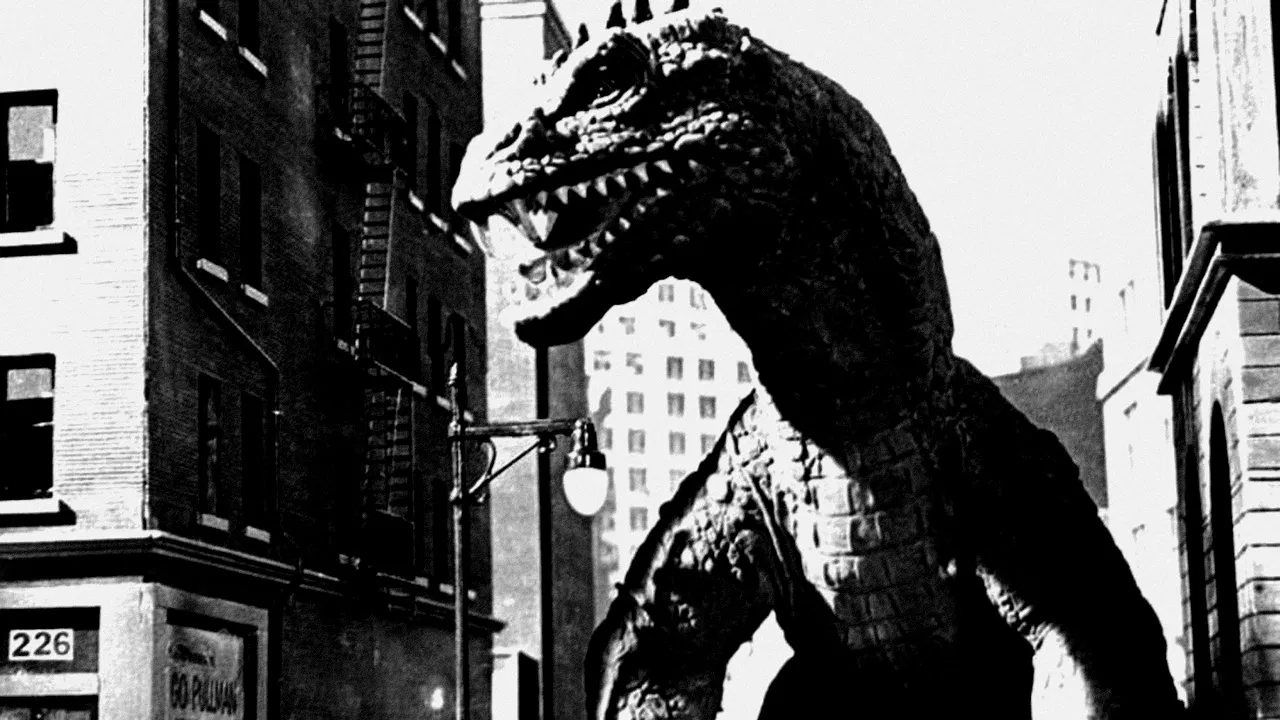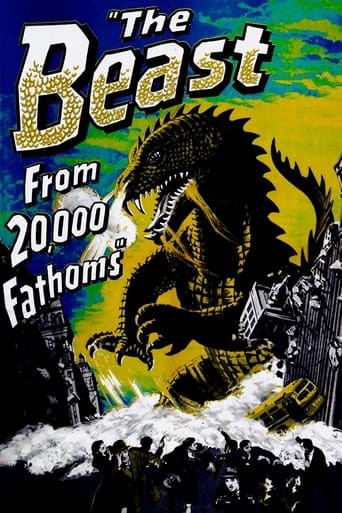

The greatest movie ever made..!
... View MoreStrong and Moving!
... View MoreEasily the biggest piece of Right wing non sense propaganda I ever saw.
... View MoreIt's simply great fun, a winsome film and an occasionally over-the-top luxury fantasy that never flags.
... View MoreBefore GODZILLA and before THEM! there was THE BEAST FROM 20'000 FATHOMS. It was the first atomic-blast-brings-giant-monster-to-attack-civilization movies ever made. Underrated? It sure is because people think that GODZILLA was the one that started it all, but really it was inspired by this movie. This was (loosely) based on a short story by Ray Bradbury under the same name (which later got changed as "The Foghorn") and this movie was Ray Harryhaussen's first spot on the stop-motion animation (since Willis O'Brien turned it town). The music purely defines the decade, tone and feel of this movie. While this movie with amazing special effects is impressive, the film as a whole is underrated, when I bring it up, only a few people heard of it, but when someone brings it up, I tell them that I heard of this movie. It would be great if this movie got remade, just like the way Peter Jackson remade KING KONG. Have the story be set in the 1950's and have the whole atomic-age paranoia be the subject. (Say, wasn't it remade in 1998 as GODZILLA? Well, I guess that the filmmakers got their monsters and story lines all mixed up.) In the 1950's Americans worried about two things: The atomic bomb and the communist threat. The giant monsters are an allegory to the bomb, while the aliens are an allegory to communism. So give it a watch, I highly recommend it. Not rated, but a PG will work due to some violence and gore there.
... View MoreThe American military is on Operation Experiment in the high arctic. They denote a nuclear bomb which thaws out a gigantic dinosaur. Professor Tom Nesbitt encounters the beast but no one believes him. He is evacuated back home while the beast inevitably moves south. It leaves a trail of destruction and reaches New York City.Everything screams 50's sci-fi B-movie. The story is nothing special. The acting is mostly stiff and so is the directing. That is everything except Ray Harryhausen's work. This is his early stop-motion model animation and it is exquisite. The giant lizard eating the NY policeman is a major signpost in the field of special effects. It is cutting edge work brilliantly done by a fledgling master.
... View MoreI love classic horror films. I watch a lot of them, so I have grown an appreciation for them. I can tolerate older styles of acting and film making that I recognize a lot of newer fans will not appreciate. That doesn't make their tastes any better or worse than mine, just different. There are some classic movies that I would recommend to anyone and everyone. A movie like FRANKENSTEIN or THE THING is just so classic and timeless that anyone should love it. There are the bottom end classic horrors, like the Universal sequels that I would acknowledge are really for lovers of the genre only and wouldn't expect Joe Public to like, at all. This movie fits somewhere in the middle of those two categories. It is not going to be loved by everyone. That's okay. On the other hand, there is a lot that's really enjoyable about this movie that makes me believe it is not just for the drive-in junkies either.Of course, what will always get talked about the most with this movie is the special effects. That may be a good or a bad thing. I cannot imagine my 17-year old nephew, for example, looking at this movie and thinking "those effects kick butt". For those who can appreciate the history of a genre, though. For those who can look at a movie like this and see the landmark effect that it had on things to come, there is a lot to love here. The movie reminds me a great deal of THE THING at the beginning. A group of scientists at work in the arctic, testing weaponry. The massive explosions that they set off have the undesired effect of unlocking a prehistoric monster from its' frozen hibernation (we'll ask you to ignore what you know of cold-blooded physiology and the fact that the animal would never wake up again. That's not relevant if you suspend belief). Naturally, nobody believes the first person who sees the monster, even after leaves the arctic and sinks a ship. Seems nobody will believe our hero until the giant lizard shows up in the Big Apple ready to destroy some stuff.The movie definitely shows its' 50sness (yes, I made up a word). We get a lot of scientific mumbo jumbo and scenes of theorizing that attempt to make the plot seem possible for the audience. Seemed every 50s film from CREATURE FROM THE BLACK LAGOON to MOLE PEOPLE shares this trait. It's the kind of a movie where military men will suddenly take orders from a random scientist and his involve his secretary girlfriend in their plans for no other reason than because they are the main stars of the movie. None of that is important, though, if you can have some imagination. What is really important, here, are the effects. Harryhausen took what he learned from his early age, working on KING KONG, and applied it to created a monster that is far superior to most of what you'll see in 50s monster movies. The monster moves fairly believably. It looks great and it blends in with the background scenery as well as can be expected for its' era. The movie was a monumental impact on the creation of GOJIRA a year later and the entire kaiju genre. For us monster junkies, that in itself, makes this movie legendary.
... View MoreBF20KF (How's that for a shorten-er!?) has Ray Harryhausen's splendid effects to thank for its continued longevity; the patience he must have had, and the devotion and love of his craft he possessed, show through in every frame of the Rhedosaur's screen time. It is, of course, an entirely fictional dinosaur, and the first two letters of its name uncannily match those of a certain animator....:) Our titanic friend is thawed out from the Arctic ice during an A-Bomb test in an impressive (apart from the obvious stock footage used) opening sequence. And like all self respecting prehistoric Dinos do, heads for New York, Tokyo presumably being a bit too far away."Sometimes I feel as if we were writing the first chapter of New Genesis.""Let's hope we're not writing the last chapter of the old." This exchange early in the film between two scientists places us firmly in the Nuclear Age paranoia of the 50s. And let's face it, that dilemma is still with us. Is all progress good? This sort of thing was done in countless sci-fi movies of the era, of course. But the succinct dialogue here really makes the point. Surprising to find such good writing in a B-movie monster flick. At least it is if you have seen as many of them as I have!Along the way we meet up with Cecil Kellaway's Paeloentologist (always welcome) his assistant, who is one of the few female leads in this type of movie that doesn't succumb to hysterics at some point, and a brilliant scene where the monster demolishes a remote lighthouse in Maine, thereby probably inspiring Stephen King. This is loosely taken from Ray Bradbury's short story The Fog Horn, and is tremendously effective.When the Rhedy gets to New York he goes the King Kong route to introducing himself to the Big Apple's citizens, though he avoids The Empire State Building and lands up at Coney Island instead. A young Lee Van Cleef plays the sharpshooter who shoots him down with radioactive isotope.Overall this is a watchable and very well done monster movie, produced, I believe, on a budget of only $150,000. Kong cost about four times that twenty years earlier. One of Harryhausen's great innovations was to get the cost of shooting stop motion to manageable proportions. His creations have real feeling behind them. Does today's CGI?
... View More